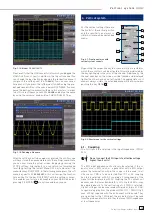
21
Subject to change without notice
D i s p l a y o f s i g n a l s
al range of 20 divisions. These may be used by the 16 digital
channels D0 to D15, the math functions and the references.
The analog channels can only use up to ±5 divisions from the
center.
Fig. 7.1: Drawing of the virtual screen area and an example
The picture above explains the function of the virtual screen. The
visible 8 divisions are shown in grey; this is the area available
for analog signals. To the right of the graticule there is a small
bar which indicates the position of the visible 8 divisions within
the possible 20 divisions. By pushing the key SCROLL BAR the
bar will be activated indicated by its color changing to blue; now
turning the universal knob will shift the visible 8 divisions (grey
area) within the available 20 divisions. This allows a simple and
clear display of many individual signal portions.
7.3. Signal intensity and persistence functions
In the standard mode, the key INTENS/PERSIST will light up
white: the intensity of the signal display can be changed with the
universal knob from 0 to 100 %. The persistence mode may be
selected for the display of varying signals: this is a storage mode
such that several curves may be written to remain on the screen.
Also the so called „Variable Persistence“ may be selected: in
this mode the persistence can be changed from 50 ms to infi nity;
this will cause the most recent portion of the signal to appear
bright while the preceeding portions will fade in proportion to
the time elapsed. This mode can be selected in the soft menu
which will open upon pushing the key INTENS/PERSIST; the
signal intensity can be changed also in this menu.
Fig. 7. 2: Menu for setting the signal display intensities
Two more menu items are available: GRID and BACKLIGHTING
by pushing the respective soft menu keys; the intensities can
be changed with the universal knob. The soft menu key next
to the lowest menu item toggles between
HIGH
and
LOW
of
the LED’s of all backlit keys and all other LED displays on the
front panel.
After selecting the menu items PERSISTENCE and ADJUST the
persistence function can be defi ned: there are 3 choices for the
duration of the persistence: OFF, AUTOMATIC and MANUAL. In
MANUAL operation, the duration can be changed with the uni-
versal knob from 50 ms to infi nity. If a fi nite time was selected,
the signal periods will be written on top of each other such that
the brightness will diminish from recent to oldest. If e.g. 300 ms
is selected, the signal curves will become darker in 50ms steps
and erased after 300 ms. In this soft menu the function BACK-
GROUND may be activated in addition: then all signal curves
ever displayed will be shown in the darkest colour.
Fig. 7.3: Persistence function
This kind of display is for example very useful for the analysis
of extreme values of different signals.
7.4. XY
display
The HMO352x has a key for directly switching to the XY function.
In this mode, two signals will be displayed, one in Y, one in X
direction. The usual time base will be replaced by the ampli-
tudes of the second signal. With harmonically related signals
the resulting curves are called Lissajous patterns; from such
Fig. 7.4: Settings in the X–Y menu
Содержание Hameg HMO3522
Страница 1: ...350 MHz Digital Oscilloscope with FFT and mixed signal option HMO3522 3524 Manual English...
Страница 33: ...33 Subject to change without notice A p p e n d i x...
Страница 34: ...34 Subject to change without notice Appendix...
Страница 35: ...35 Subject to change without notice A p p e n d i x...
















































